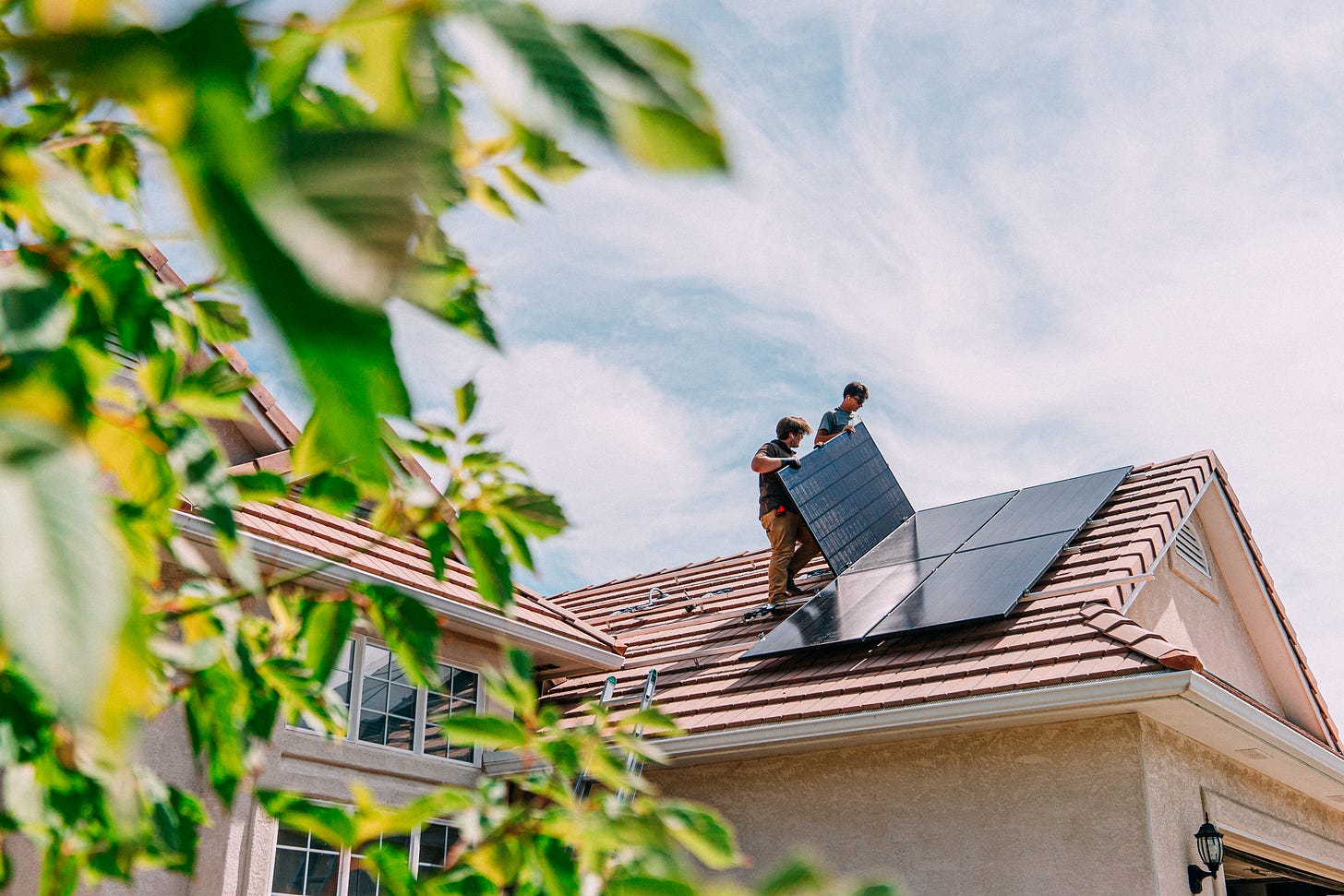The Problem With Solar
It's basically free—but at the same time it's hideously expensive. What gives?
By now you’ve heard the news: solar energy panels have gotten so cheap, the power you get from them is basically free. Solar is now nearly always cheaper to generate than power from coal-fired plants. Despite decades of skepticism and fossil fuel industry obstructionism, the cost curves for photovoltaic generation have come down farther and faster than anyone thought possible. Cue the breathless headlines: the age of basically-free solar power for all is upon us!
This is all true.
You may also have heard—though not as loudly—that a renewables-only grid would be outrageously expensive. So much so that nobody’s ever managed it. The technology just isn’t there for it. Solar power works where taxpayers kick in fat subsidies, otherwise forget it. That, the doubters whisper, is why so much new solar installation happens in rich countries: without a fat tax base able to subsidize a solar grid, it doesn’t work.
This is also true.
But how can both these things be true at the same time?
The answer is that, yes, solar power generation has become close to free… but only when the sun is shining. Which happens some of the time, but not all of the time, not predictably and not necessarily at the times people need power the most.
The dirty little secret is that, at the scale relevant to most people, solar generation’s cost advantage is sort of beside the point. For solar to serve as the backbone of a grid, it needs to be backed with storage. That can come in the form of batteries, hydrogen, or pumped hydro. All of these are expensive; none of them scale. Storing a kilowatt-hour of electricity in a chemical battery costs an order of magnitude more than just generating it in a nuclear power plant. Which is why a 100% solar grid would be insanely expensive, even though generating solar power is basically free.
Unfortunately, that dirty little secret—a fundamental reality of the operation of the energy grid—is often left out of the energy conversation. The solar hype machine continues to tout the benefits of solar without much understanding of how solar fits into a more complicated picture.
If all the terminology gets a bit confusing, this little fable might help.
Imagine you wake up tomorrow to news that scientists have invented a machine that renders hamburgers both environmentally benign and pretty much free. Environmentalists are delighted! There’s just one catch—the machine makes those burgers at random times, and if you don’t eat them the moment they’re made, they go bad.
Your kid, who is very concerned about the environment, hectors you into buying one of these machines. It whirs into action at 8:47 a.m. and makes three burgers, only you’re doing your school run just at that time. “Bad luck!” you think, as you throw out the spoiled burgers. The machine next springs to life at 2:09 p.m., at which time you wolf down the two burgers it makes only for the darn thing to crank up again at 4:12 p.m. when you’re at the gym. Once, it made nothing for a whole weekend.
You start realizing that however free those burgers may be, you’re still going to have to rely on the grocery store down the street for a fair bit of your food. Along comes an environmentalist politician who decrees that, since these near-free-burgers are so eco-friendly, the neighborhood grocery store will be required to buy any unwanted burgers from you at a fixed price. This is the Burger Feed-in-Tariff, and I’m sure you can imagine how popular that rule is going to be with the grocery store.
With the new rules, the grocery store is forced to buy the burgers your machine makes, even at times when nobody wants any burgers. The grocery store has no good options for what to do with these unwanted burgers. It can either buy the exotic, high-tech $3 million refrigerator it takes to store them, or else it ends up paying people to take burgers off its hands.
At this, your enviro-kid rejoices: negative burger pricing! The future is here!
But the system means mayhem for the grocery store’s whole business model. What used to be a stable clientele buying a predictable amount of food has turned into a crap-shoot. A system set up to buy food from wholesalers and distribute it to consumers now has to build a whole complicated new infrastructure to buy food from consumers as well: a complicated new “smart grocery store” infrastructure to handle the reverse flow. That’s expensive!
Worse, when one customer’s machine starts off-loading burgers nobody wants, every customer’s machine starts off-loading burgers nobody wants. The high-tech fridges it takes to store them are insanely expensive and their capacity is limited. At times it gets so bad, the grocery store has to implement burger curtailment: paying customers to unplug their burger machines so they won’t start flooding the store with unsellable, unstorable hamburgers.
The grocery store’s operations are now in constant turmoil. In time, they’re forced to raise prices for their regular groceries to cover the additional costs associated with distributing “free” burgers.
At which point your kid rolls his eyes at you and wonders how you can be so foolish as to pay higher and higher prices for that gnarly food from that rickety old grocery store when the burgers the machine makes are free. Green activists will scoff at outdated old polluting supermarkets that, absurdly, insist on raising prices in an age of free burgers!
This, broadly speaking, is the dynamic between solar generation and grid operators today. For a very few, very niche uses that require a lot of cheap power whenever it’s available, solar is great. Real world grid operators, on the other hand, need a steady source of power that customers can rely on around the clock.
Solar enthusiasts tend to talk as though the recent weirdness in solar markets—curtailment payments, and those mind-bending negative wholesale power prices—are a feature rather than a bug: proof of the radical power that abundant solar affords. In fact, they’re signs of a market dangerously unbalanced.
In principle, you could sidestep many of these problems with batteries. And yes, battery prices are coming down, quickly. But no, they’re nowhere near the level they’d need to be to make solar plus battery storage cost-competitive at grid scale.
We know this for a fact because the only kinds of places that ever seem to install grid-scale storage are rich jurisdictions with generous subsidy regimes. How generous? A report by the Public Utility Commission of California shows that, last year, homeowners with solar panels pocketed $8.5 billion from customers without them. Solar plus batteries are cost competitive… if you rig the market in favor of solar plus batteries. Meanwhile, where grid-scale solar has been tried in poor countries that don’t have billions to throw around in subsidies, it’s sputtered to a stop pretty quickly, with, for instance, only three takers in the developing world for the IFC’s much-vaunted Scaling Solar Program.
These are real problems—the kinds of problems that need to be addressed and overcome—but the solar hype machine tends to elide them. Unfortunately, that kind of starry-eyed boosterism has consequences. Casual news readers, informed that solar power is now near-free, become even more reluctant to support grid solutions that seem retrograde in comparison. With trusted sources of envirotruth declaring victory for solar, nothing but unconditional surrender by all other sources seems acceptable.
The story is not so simple. A time may yet come when a radical storage breakthrough makes solar’s cost advantage meaningful at scale. But some big companies have been working hard on that future for decades… and haven’t cracked it. So, for the foreseeable future, solar will stay both basically-free and insanely-overpriced—and solar hype will continue to confuse our energy situation more than actually helping it.
Francisco Toro is a contributing editor at Persuasion and writes the Substack One Percent Brighter. Guido Núñez-Mujica is Head of Data Science at the Anthropocene Institute.
Follow Persuasion on Twitter, LinkedIn, and YouTube to keep up with our latest articles, podcasts, and events, as well as updates from excellent writers across our network.
And, to receive pieces like this in your inbox and support our work, subscribe below:






Great article! Thanks fort writing it!! I used to be an ardent--and somewhat naive--supporter of solar and wind energy production. In fact I devoted a major portion of my career to innovating in that space. It was around 2000 when solar industry insiders woke up to the criticality of grid scale energy storage. I was part a team that pioneered grid scale rapid response to short term fluctuations in supply vs demand, and we did so specifically to enable wind and solar. The work was fantastically interesting and my career went well for me personally. But while many have been gainfully employed and sometimes even enriched, and while many politicians and activists have been glorified, the tech companies and the investment community has thus far failed to provide solutions that will allow grid energy storage to keep up with the public and political enthusiasm for renewables. For me personally it has added up to a life lesson on some of the limits of democracy and how far removed policy makers can become when huge practical issues get sharply politicized. In the present pollical environment, climate activists have the upper hand and they are aggressively pushing politicians to enact policy decisions without including enough input from actual experts in energy production and distribution. (Anybody who scoffs at this remark probably needs to get outside their social and political comfort zone and do a little more digging.) Most of the people I talk to about wind and solar literally have no idea that energy storage is a factor and that the present grid infrastructure can only handle a small percentage of wind and solar given the existing storage facilities and technologies. Maybe some team at McKinsey has it all sorted, but it seems to me like the public and the politicians are ill informed as to the net environmental and geopolitical impact that will be inflicted on the world if we rapidly build out a sufficient battery storage infrastructure to catch up with the current rate of growth in so called sustainable sources. Speaking from my own decades long experience in this arena my own personal opinion is that the massive concentration of capital into wind and solar has been a terrible mistake and we should have focused a much bigger share of those resources into nuclear power. People who scoff at nuclear often assert we don't have the right technology yet, but the same criticism entirely applies to grid scale energy storage which may prove to be even more elusive that fusion. There are some very promising entrepreneurial efforts to revolutionize large scale battery storage, and I hope it works out-- but I doubt that we would have opted for the current path if we as a society had done a better job involving industry experts and analyzing the tradeoffs between renewables and nuclear.
These issues of storage and consistent power generation are what have me freaked out about the electrification of everything (e.g. heavily subsidizing people to switch to induction cooktops, split units for heating/cooling/hot water, etc.). That power still has to come from somewhere, and when everything is taxing the electric grid, which is already stretched to the max in states like California... I just don't see a whole lot of good outcomes. Efficient appliances that don't work at peak hours because there's not enough juice are sort of an insult to the people relying on them for heat.